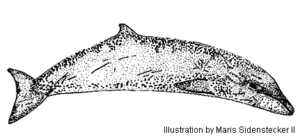 TRUE'S BEAKED WHALE
TRUE'S BEAKED WHALE
Mesoplodon mirus
True, 1913
DERIVATION: from the Latin mesos for middle, hopla for arms, odon for tooth; meaning
armed with a tooth in the middle of the jaw; and mitrus for wonderful or amazing.
The genus Mesoplodon contains many obscure and confusing species, some of which are known from a few specimens. A living example of one species, Mesoplodon pacificus , has never been seen, but it was identified from two skulls found on beaches.
Characteristics of beaked whales include a spindle-shaped body, wide flukes without notches, small flippers, and an elongated snout that may account for the name "beaked whale." All members of the family have two throat grooves that converge toward the snout.
Scars are often present on their bodies. Most authorities attribute the single or parallel scars on beaked whales to other males of the same species fighting over females. This is possible, but not proven since their is a scarcity of observations of beaked whale behavior in the wild.
The most unusual characteristic of these whales, however, is its teeth. In males, they regularly protrude above the gumline, but not in females. In each species of Mesoplodon , this single pair of fully developed teeth is shaped and positioned in a distinctive manner.
Mesoplodon mirus males have two teeth located at the very tip of the mandible which angle slightly forward and can be seen outside the mouth. The tip of the lower jaw extends slightly beyond the upper jaw. The teeth of the females remain embedded in the gums and they are not as heavy and thick as the male's teeth. Even in males, the teeth are relatively small for the genus; they rarely exceed two inches.
The color of M. mirus is dull black to dark gray on the back, lighter slate gray on the sides, the belly is gray, and there are light spots or blotches, especially in the genital and anal regions. They are a small species, reaching a known maximum length of 17.5 feet.
The most knowledge we have of M. mirus comes from strandings in the temperate North Atlantic and in southeastern Africa. They were believed to dwell only in the North Atlantic until recently, but in 1959, a specimen was found in Cape Province, South Africa. Since then, several more South African specimens have been reported. Strandings have occurred between northeastern Florida and Nova Scotia in the western North Atlantic; in the eastern North Atlantic off the British Isles.
It has been more than two centuries since the description of the first beaked whale, but little more is known about them now. The beaked whales are the least known large animal in the world. We don't know when or where they breed, and it is not really known how many different species there are. It is not even known if they are passing from existence or proliferating.
By: Maris Sidenstecker
